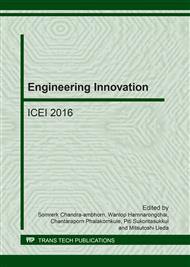[1]
Information on https: /www. en. wikipedia. org/wiki/Artificial_leather.
Google Scholar
[2]
X. You, L. Gou, X. Tong, Improvement in surface hydrophilicity and resistance to deformation of natural leather through O2/H2O low-temperature plasma treatment, Applied Surface Sci. 360 (2016) 398-402.
DOI: 10.1016/j.apsusc.2015.11.030
Google Scholar
[3]
N.S. Cohen, M. Odlyha, G.M. Foster, Measurement of shrinkage behaviour in leather and parchment by dynamic mechanical thermal analysis, Thermochimica Acta. 365 (2000) 111-117.
DOI: 10.1016/s0040-6031(00)00618-3
Google Scholar
[4]
J.H. Choi, E.S. Lee, H.K. Baik, S. -J. Lee, K.M. Song, M.K. Hwang, C.S. Huh, Surface modification of natural leather using low-pressure parallel plate plasma, Surface Coat. Technol. 171 (2003) 257-263.
DOI: 10.1016/s0257-8972(03)00282-2
Google Scholar
[5]
C.W. Kan, C.H. Kwong, S.P. Ng, Surface modification of polyester synthetic leather with tetramethylsilane by atmospheric pressure plasma, Applied Surface Sci. 346 (2015) 270-277.
DOI: 10.1016/j.apsusc.2015.03.111
Google Scholar
[6]
M.J. Rupérez, E. Giner, C. Monserrat, E. Montiel, Simulation of the behavior of the calfskin used as shoe upper material in footwear CAD, Computer-Aided Design. 44 (2012) 1205–1216.
DOI: 10.1016/j.cad.2012.06.009
Google Scholar
[7]
F. Liravi, S. Das, C. Zhou, Separation force analysis and prediction based on cohesive element model for constrained-surface stereolithography processes, Computer-Aided Design. 69 (2015) 134-142.
DOI: 10.1016/j.cad.2015.05.002
Google Scholar
[8]
Y. -S. Lee, H. -W. Kim, J. -H. Cho, Process parameters and roll separation force in horizontal twin roll casting of aluminum alloys, J. Mater. Process. Technol. 218 (2015) 48-56.
DOI: 10.1016/j.jmatprotec.2014.11.031
Google Scholar
[9]
Y. -S. Lee, H. -W. Kim, J. -H. Cho, Effect of casting parameters on roll separation force during twin roll casting, Procedia Eng. 81 (2014) 1547-1552.
DOI: 10.1016/j.proeng.2014.10.188
Google Scholar
[10]
S.B. Zelicof, J. D. Blaha, S. Nambu, M. Carroll, Evaluation of the Separation Force for Various Artificial Hip Bearings, J. Arthroplasty. 22 (2007) 302.
DOI: 10.1016/j.arth.2006.12.010
Google Scholar
[11]
D.C. Montgomery, Design and analysis of experiments, sixth ed., Johnson Wiley & Sons, Inc., New Jersey, (2005).
Google Scholar
[12]
J. Javorsky, M. Franchetti, H. Zhang, Determining the optimal parameters of bonding polyvinylchloride to stainless steel in automotive applications with the use of full factorial design of experiment, CIRP, J. Manufact. Sci. Technol. 7(2014).
DOI: 10.1016/j.cirpj.2013.12.004
Google Scholar
[13]
Y.M. Z. Ahmed, M.I. Riad, A.S. Sayed, M.K. Ahlam, M.E.H. Shalabi, Correlation between factors controlling preparation of porous copper via sintering technique using experimental design, Powder Technol. 175 (2007) 48-54.
DOI: 10.1016/j.powtec.2007.01.027
Google Scholar
[14]
J. Grum, J.M. Slabe, The use of factorial design and response surface methodology for fast determination of optimal heat treatment conditions of different Ni–Co–Mo surfaced layers, J. Mater. Process. Technol. 155-156 (2004) 2026-(2032).
DOI: 10.1016/j.jmatprotec.2004.04.220
Google Scholar
[15]
D. Njoya, M. Hajjaji, Quantification of the effects of manufacturing factors on ceramic properties using full factorial design, J. Asian Ceramic Societies. 3 (2015) 32-37.
DOI: 10.1016/j.jascer.2014.10.002
Google Scholar
[16]
Information on http: /www. morbern. com/wp-content/uploads/2013/11/Standard-Test-Methods-CFFA. pdf.
Google Scholar


